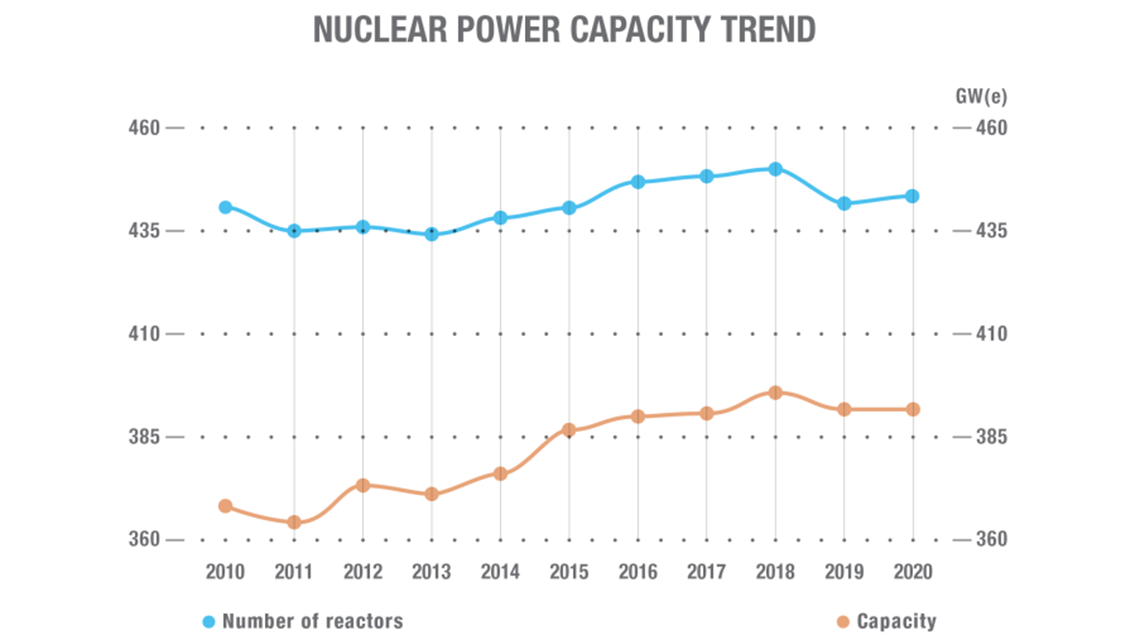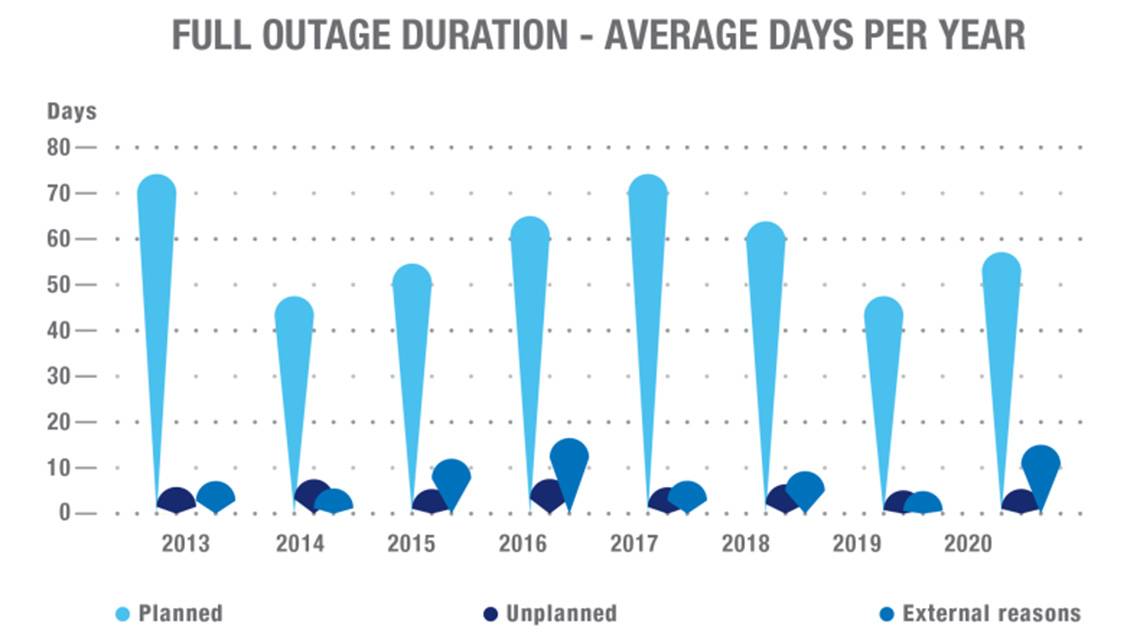Nuclear power operators around the world sustained reliable nuclear power plant (NPP) operation during the COVID-19 pandemic, according to 2020 nuclear power operating data. The IAEA today released its annual nuclear power status data for 2020, collected by the Power Reactor Information System (PRIS), the IAEA’s publicly available and comprehensive database on nuclear power. The utilization of available nuclear power capacity provided reliable, low-emission electricity throughout the COVID-19 pandemic.
Nuclear Power Proves its Vital Role as an Adaptable, Reliable Supplier of Electricity during COVID-19
Restrictions on economic and social activity during the COVID-19 outbreak in 2020 led to an unprecedented and sustained decline in demand for electricity in many countries, at 10% or more, compared to 2019 levels. This created challenges for both electricity generators and system operators. Low-carbon electricity prevailed with the increasing contribution of renewable electricity, and nuclear power generation proved to be resilient, reliable and adaptable. The flexibility of nuclear power demonstrated how it can support the clean energy transition.
Cedric Lewandowski, Vice President and Group Senior Executive of EDF’s Nuclear and Thermal Division, noted that electricity consumption fell about 15% in France during the lockdowns, and most of the demand was met by nuclear, hydro and other renewables. The flexibility of the nuclear fleet was used extensively, with the number of load variations up by 50% compared to the same period in 2019.
At the end of December 2020, the global operating nuclear power capacity was 392.6 GW(e) from 442 operational nuclear power reactors in 32 countries. Overall, nuclear power capacity since 2011 has gradually increased, including some 23.7 GW(e) of capacity added by the connection of new units to the grid and upgrades to existing reactors.
During the year, operators focused on the continued operation of the nuclear power plants, protection of staff and implementation of innovative approaches to conduct their businesses. The pandemic forced no direct shutdowns, nor did it have any direct impact on nuclear power operation, according to the 2020 PRIS operating experience data. However, the pandemic impacted schedules of planned outages for refuelling and maintenance due to disruptions in supply chain, travel restrictions or limitations on external staff permitted on site.
Unplanned outages due to external reasons, such as significant decreases in electricity demand, increased to 15 average days in 2020, in comparison to 5 days in 2019. Flexible NPP operation — or, in some cases, complete short-term shutdowns — supported grid operator needs and demonstrated nuclear power’s ability to integrate into sustainable energy systems of the future, which are expected to rely significantly on flexible baseload generation technologies.
Throughout 2020, nuclear power reactors supplied 2553.2 TWh of low-emission and dispatchable electricity, which accounted for about 10% of total global electricity generation and nearly a third of the world’s low-carbon electricity generation. The 2020 nuclear power production was slightly lower compared to 2019, when the world’s nuclear reactors produced 2657.1 TWh. Lower nuclear generation occurred in Africa due to decreased electricity demand and in North America and Western Europe due to lower demand and retired capacity. However, the historical trend of nuclear power generation demonstrates a continuous growth over the past years, with over 8% increase since 2012.
In 2020, total global operating capacity increased slightly by some 0.5 GW(e) compared with 2019, however, the number of reactors decreased by one compared to 2019. Near- and long-term capacity growth prospects are centred in Asia, which at the end of 2020, reported 34 reactors with some 34.6 GW(e) of nuclear power capacity under construction.
Capacity added and units connected to the grid. In 2020, five new pressurized water reactors (PWR) with 5.5 GW(e) of new nuclear capacity were connected to the grid. Asia dominated the new nuclear capacity market in 2019, hosting over 77% of all new capacity additions that year, and during 2020, Asia delivered 36% of new capacity additions with 2 GW(e) connected to the grid in China at Fuqing-5 (1000 MW(e)) and Tianwan-5 (1000 MW(e)). In 2020, more than 44% of new capacity equating to over 2.4 GW(e) was added by two countries with no previous nuclear power operating experience – Belarusian 1 (1110 MW(e)) in Belarus and Barakah-1 (1345 MW(e)) in the United Arab Emirates. In Russia, Leningrad 2-2 was connected to the grid in October 2020 with a total capacity of 1066 MW(e), replacing Leningrad-2 (925 MW(e)), which was permanently shut down in November 2020 after 45 years of operation.
New build construction. The new construction trend has remained steady in recent years, with slower growth in 2020, compared to the previous three years. At the end of 2020, 52 reactors with over 54.4 GW(e) of capacity were under construction in 19 countries, including in two countries building their first nuclear power reactors. Asia continues to be the dominant region in new reactor construction, where a total of 64 reactors with 58.5 GW(e) operational capacity have been connected to the grid since 2005. In 2020, the construction of four PWR reactors began, with three reactors in China (Sanaocun-1 (1117 MW(e)), Taipingling-2 (1116 MW(e)) and Zhangzhou-2 (1126 MW(e)) and one reactor in Turkey (Akkuyu-2 (1114 MW(e)).
Capacity removed and permanent shutdowns. In 2020, six reactors (5.2 GW(e)) were permanently shut down globally. Leningrad-2 (925 MW(e)) in Russia shut down in November. Two reactors shut down in the United States – Indian Point-2 (998 MW(e)) and Duane Arnold-1 (601 MW(e)) in April and October, respectively, after more than 46 years of operation each. France’s two oldest nuclear reactors, Fessenheim 1 and Fessenheim 2 — each 880 MW(e) — shut down last year in February and June, respectively. Both operated for more than 42 years. Ringhals-1 (881 MW(e)) in Sweden shut down on the last day of 2020, after more than 46 years of service.
Operational reactor types. As of the end of 2020, some 89.5% of the operational nuclear power capacity was comprised of light water moderated and cooled reactor types; 6% were heavy water moderated and cooled reactor types; 2% were light water cooled and graphite moderated reactor types, while 2% were gas cooled reactor types. The remaining 0.5% were three liquid metal cooled fast reactors with a total capacity of 1.4 GW(e).
Non-electric applications. In 2020, 64 nuclear power reactors in 10 countries applied 3396.4 GWh of electrical equivalent heat to support non-electric applications of nuclear energy. Over 92% of the non-electric applications were utilized in Europe, generating 1999.4 GWh of electrical equivalent of heat to support district heating and 1231.7 GWh for process heating by 56 reactors. The remaining 8% was utilized by 8 reactors in Asia to generate 34.7 GWh of electrical equivalent of heat to support water desalination and 130.6 GWh to support process heating.
Operational lifetime. At the end of the 2020, the worldwide cumulative operating experience over 66 years amounted to over 18,772 reactor years, from 634 reactors with a total capacity of 479.9 GW(e) across 35 countries. Of this, 192 reactors with 87.2 GW(e) have been permanently shut down.
Over 67% of total operational reactor capacity (256.3 GW(e), 296 reactors) have been in operation for over 30 years. Twenty percent of global operating nuclear capacity (104 reactors) have been in service for over 40 years, while 1% has been operating for over 50 years. The aging nuclear fleet highlights the need for new or upgraded nuclear capacity to offset planned retirements. Utilities, governments and other stakeholders are investing in long term operation and ageing management programmes for an increasing number of nuclear power reactors globally to ensure sustainable operation and a smooth transition to new capacity.
Unit performance. Even as the nuclear power fleet ages, operational NPPs continue to demonstrate high levels of overall reliability and performance. The load factor, also referred to as the capacity factor, is the actual energy output of a reactor unit divided by the energy output that would be produced if it operated at its rated power output (reference unit power) for the entire year. A high load or capacity factor indicates good operational performance. In 2020, the global median capacity factor was 84.6%, in line with the load factor in recent years.
Another indicator measuring the performance of nuclear reactors is the energy availability factor (EAF), which refers to the ratio of energy that the available capacity could have produced during a specific time period, compared to the energy that the reference unit power (RUP) could have produced. In 2020, the weighted average EAF was 76%, where half of nuclear reactors also operated with an EAF above 87%.
The reliability and safety of nuclear power reactors continues to improve. The graph above demonstrates a gradual reduction of unplanned manual (UM7) and automatic scrams (UA7) per 7000 hours (approximately one year) of operation per unit since 2003. The reduction in the number of unplanned scrams is attributed to a history of continuously improving plant operations and maintenance management.
Based on the latest IAEA nuclear capacity projections, nuclear power will continue to play a key role in the world’s low-carbon energy mix, with global nuclear electrical capacity projected to double by 2050 in the high case scenario. The world’s nuclear power industry has not only proven that it can be flexible during a pandemic, but it also continues to serve a vital role in sustainable climate change mitigation.
For more nuclear power statistical data and related graphics, refer to the Agency’s PRIS database. PRIS has been developed and maintained by the IAEA since 1969, based on information from officially nominated counterparts in countries worldwide.
PRIS data are also used as the basis for three annual IAEA publications:
- Operating Experience with Nuclear Power Stations in Member States (OPEX) contains a historical summary of performance during the lifetime of individual plants and figures.
- Nuclear Power Reactors in the World, Reference Data Series No. 2 (RDS-2) presents the most recent reactor data available to the IAEA, summarizing information as of the end of 2019 on power reactors operating, under construction and shut down in addition to performance and specification data.
- The PRIS Nuclear Power Status infographics poster visually presents the status of nuclear power in the world. It summarizes status changes, regional statistics, operating experience, country statistics, among other key facts.
__________
- Nuclear power operating statistics do not include outage data from French reactor units as information for these units was not available by the time of publication.
- Information and data received by the IAEA through 1 June 2021 are included in this publication. Any modifications received at a later date are available in the PRIS database.


















